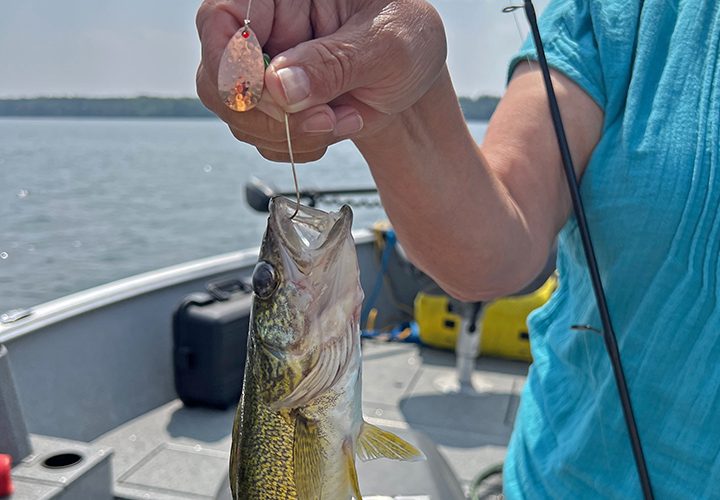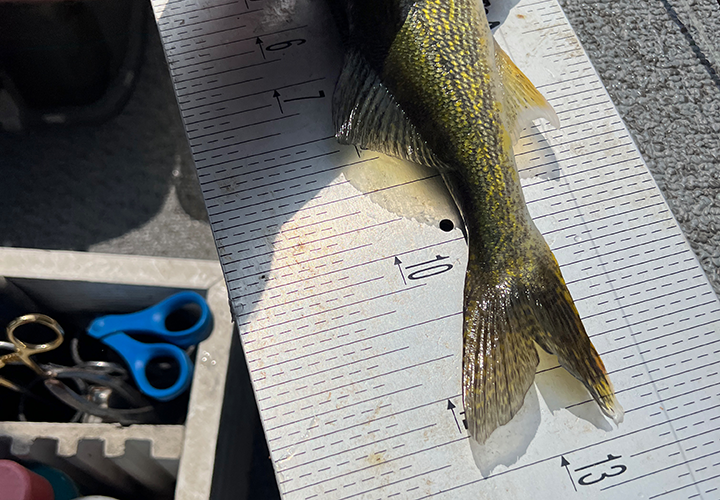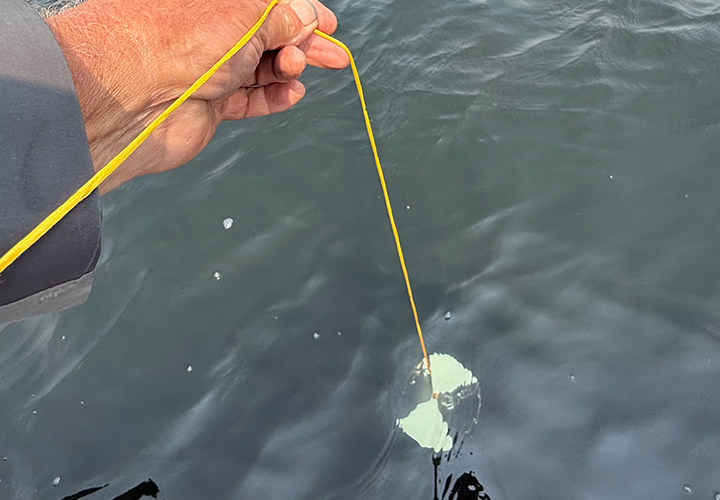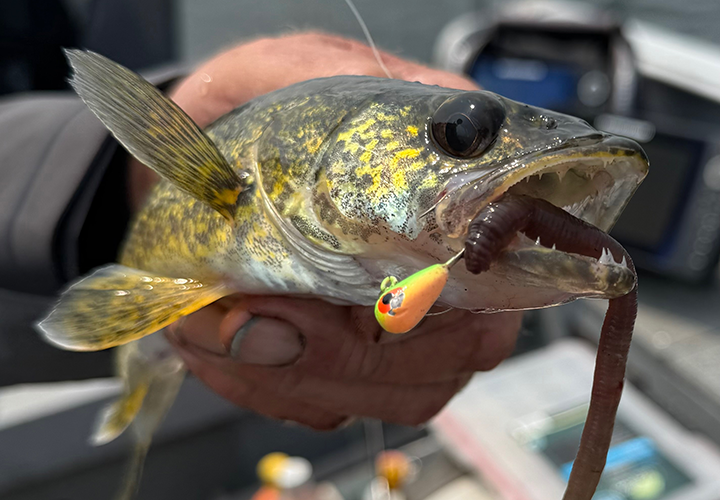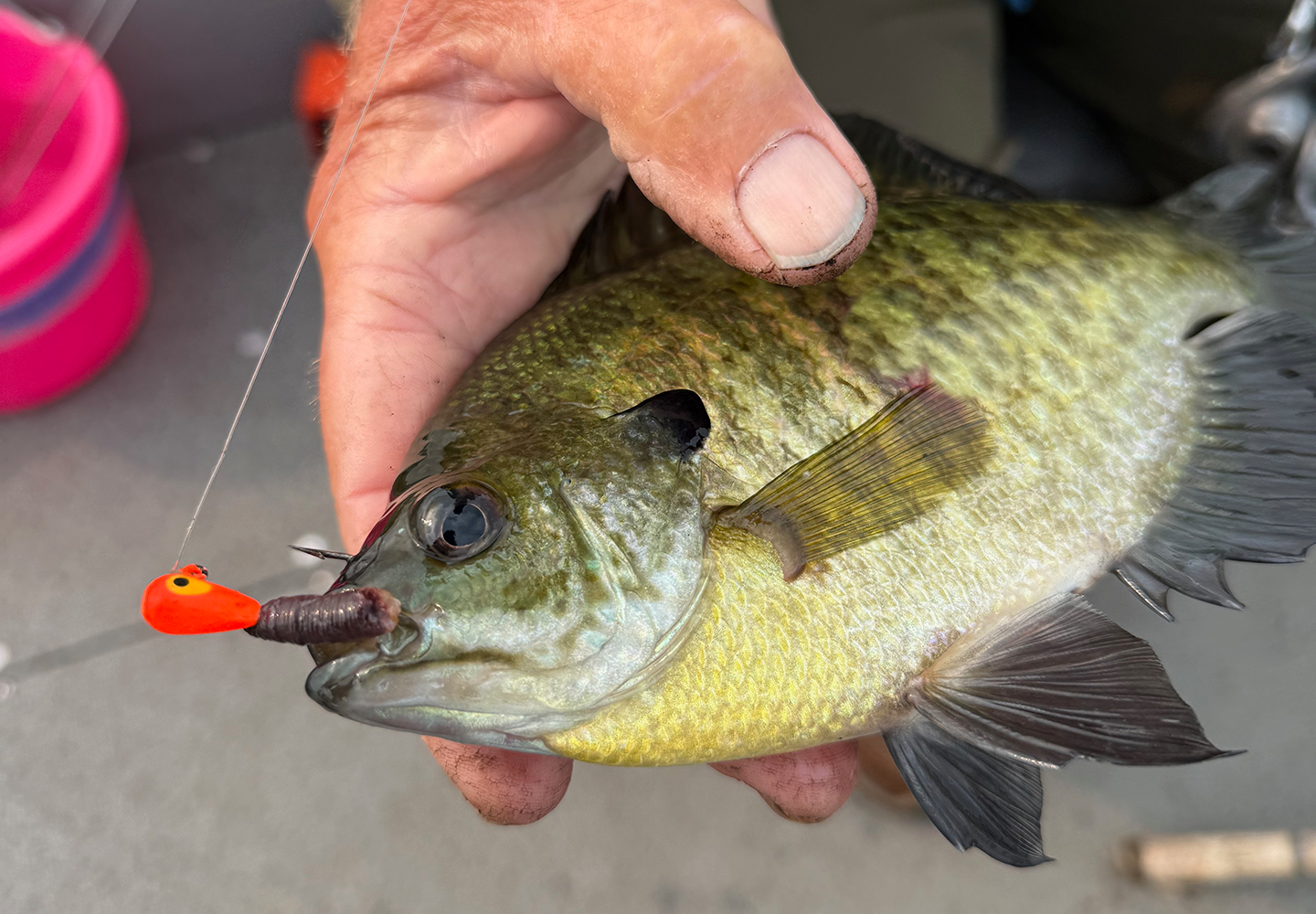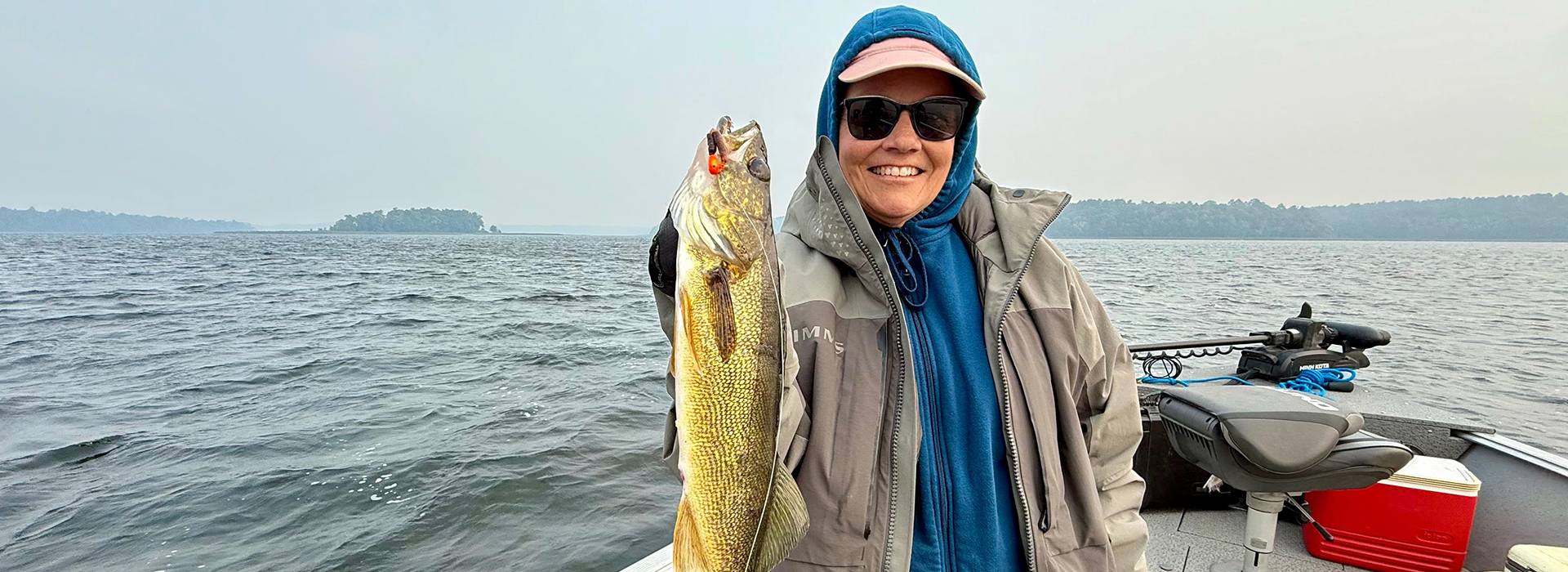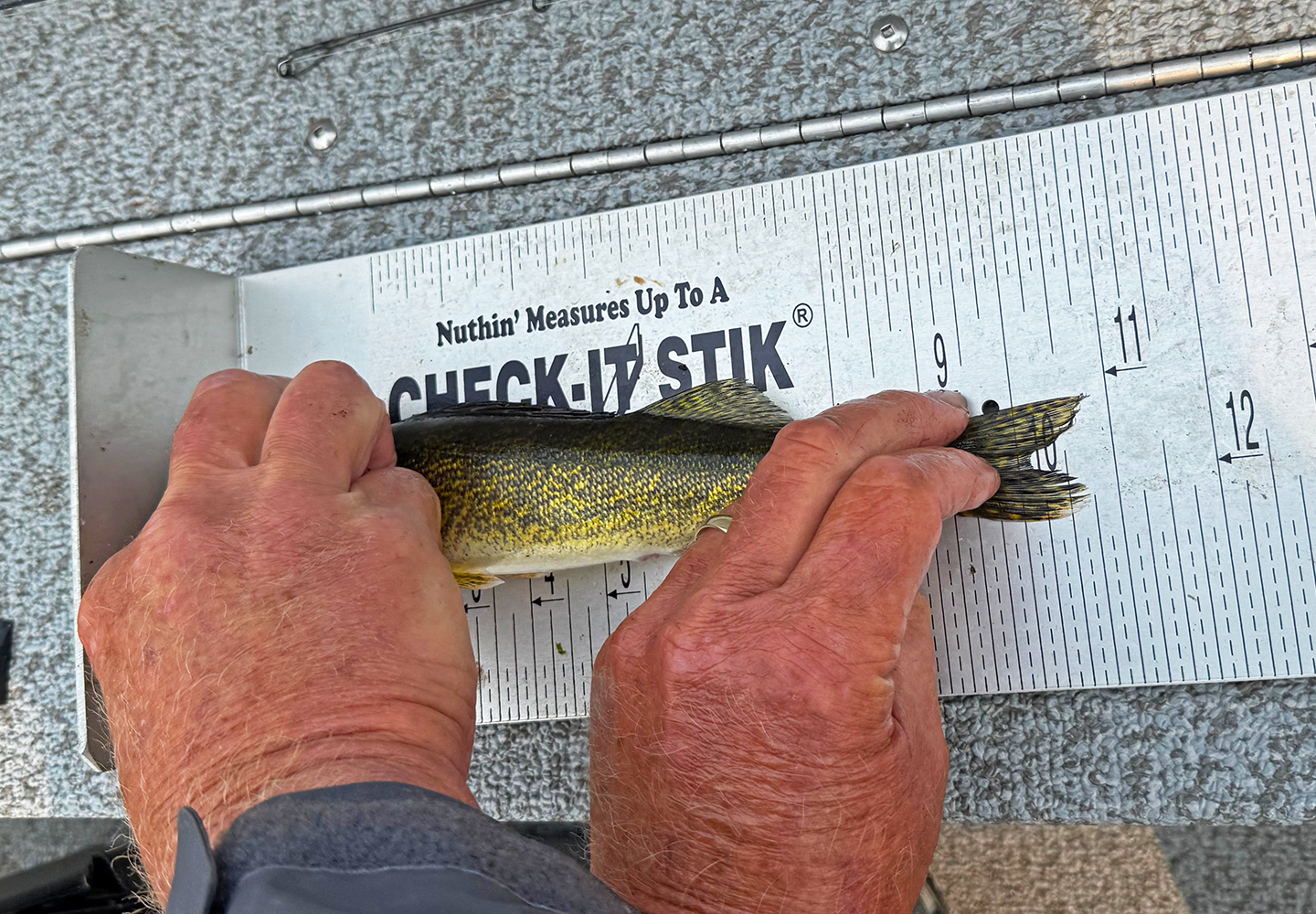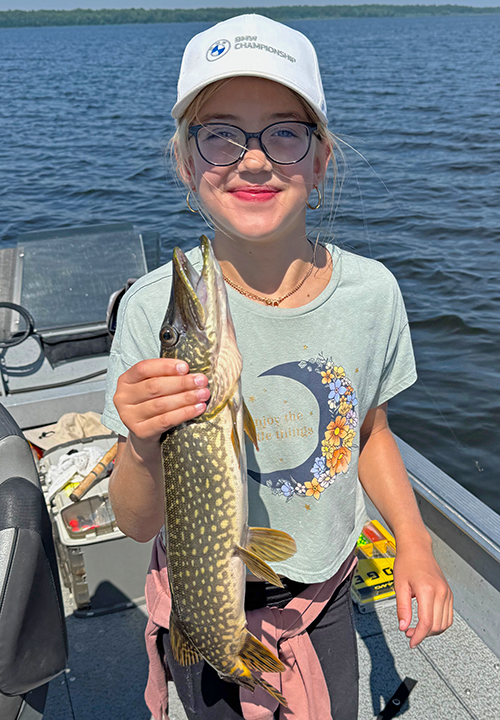The news of the week on both Lake Winnie and Cutfoot Sioux are the heavy rains that saturated bogs, and backwater lowlands. As a result, there has been a steady increase in the flow of water from small reivers and streams. With the increase in warmer, nutrient rich water flow comes a decrease in water clarity.
The Secchi disk reading, taken offshore near Raven’s Point on Thursday was 11 feet. Still clear by historic standards, the 11-foot reading represents a full 50% reduction from the 22-foot water clarity we reported back in early June 2025. That’s good news for anglers who have battled ‘boat shy” walleyes, pike and panfish. Reports of sighting fish on electronics, and catching them, in shallow 10-to-12-foot water depths is encouraging.
Walleyes held, and were caught in shallow water thanks to declining water clarity
In the aftermath of thunderstorms that affected our region on Wednesday, perch, pike and walleye action was sluggish. That said, there were still some “catchable fish” and that’s a good sign, we think. If fish bite on the days when they’re not supposed too, action is more likely to be good when weather conditions are favorable.
For now, finding vegetation is one secret to consistent fishing action. Heavy growth, like stands of cabbage and coontail hold perch, sunfish and pike. Less dense stands of submerged plants like flat stemmed pondweed, and other pondweed varieties are holding some crappies, more pike and at times, walleyes.
Surface temperatures rose into the mid-70s during mid-July. But this week they declined and ranged between 70 to 73 degrees as of 7-24-25. The decline in water temperatures is likely to mean that we’ve already seen the warmest conditions of the season. Affected by cooling temperatures, trolling presentations now produce fewer sunfish, rock bass and other “warm water species”. Spinners, tipped with minnows will continue to produce walleyes, pike and perch though, and remains a mainstay presentation for many anglers, especially those who fish on the big lake.
Spinners tipped with live bait is an effective trolling presentation on Lake Winnie
We reported that wiggle worming had been a productive presentation for folks who targeted walleyes on Cutfoot Sioux. Alternative presentations like Lindy Rigging with lively leeches and air injected night crawlers have produced walleyes too. In the fish cleaning shack, one pair of walleye fishermen said, “our catch, 7 keeper walleyes and a half dozen keeper sunfish wasn’t bad, but we did have to put up with a lot of small perch.”
It is true, there are a lot of small perch in the system right now, and they are very good at attacking baits that are intended for other game fish. The gamefish though, walleyes, are feeding on those small perch. So, putting up with the unwanted attention from little perch is unfortunately part of the secret to success in catching walleyes.
Some anglers report that using large swim baits is one alternative to live bait, and a remedy for pesky perch syndrome. Casting to the edges, pockets and gaps in shoreline vegetation with 1/8 to ¼ ounce jigs tipped with 3-to-4-inch plastics will work. Use a steady swim-drop, swim-drop retrieve, allowing your lures to work deep into the cover. Paddle tails, shad imitators and jerk baits are good, bucktail jigs have been gaining in popularity too, experiment and let us know how they work for you.
Last week we wrote, “Walleyes during mid-summer often find small spots of hard bottom structure within stands of vegetation.” Focus on these small, spot-on-a-spot locations and your productivity will rise. In case you missed it, or need a refresher, read our fishing report July 13, 2025.
Mid-lake structures are always popular spots for locating and catching walleyes during mid-summer. During late summer, we expect to see a shift away from the smaller, isolated “humps”. Walleye populations tend to build up on the lake’s larger bars like the Bena Bar, Horseshoe, Moses, Center and Sugar. Watch for schools of walleyes along the edges, where shallower water meets the lakes deeper basin. The most active fish will hold high along the edges or even spread out across the tops of these massive structures. Key water depths are 14 to 24 feet.
Trolling spinners, combined with bottom bouncers will allow for efficient searching. Once located, use Lindy Rigs and Live bait, slip floats or again, cast jigs tipped with swim jigs or paddle tails. Some folks prefer to focus on northern pike, and for them, trolling large crankbaits is effective. Use lures that run 10 to 12 feet deep and focus on isolated patches of gravel or rock on top of the bars.
Walleyes from the 2023 year class are growing, and now range from 12-1/2 to 13-1/2 inches
We’ve been following and reporting on the progress of walleyes from the 2023-year class. Observations from guests and friends on the lake continue to support the notion that there are a decent number of fish from that year in the system. Now measuring at 12-1/3 to 13-1/2 inches, the young walleyes promise to provide some “keepers” soon. We’ve long suggested following a voluntary guideline of 14 inches before harvesting, and its likely fish in that size range will be available later this fall. Harvest sparingly now, and the season outlook for 2026 should be a good one.
Perch fishing has been spotty for our guests this summer, but catches are somewhat more consistent now. Numerous reports of perch feeding on adult crawfish have been coming in. To find larger perch, 10 to 11 inches in length, seek out areas where vegetation and gravel or light rocks are combined. Picture structures where crawfish thrive, and you will have the recipe for location of keeper size perch as well.
We mentioned earlier that there is a strong population of young yellow perch in the system right now. Pesky as these small fish are right now, they will mature, and when they do, better fishing for quality size perch will be available. We’re looking forward to that!
Recently, we reported an announcement by the Minnesota DNR Fisheries Chief, Brad Parsons, about his plans to go forward with a statewide walleye possession limit reduction. Presently set at 6 walleyes, the new limit, if enacted, would allow our guests and visiting anglers to return home with 4 walleyes instead.
We encouraged you to participate in an online survey aimed at gauging public opinion about the rules change. We reported too that the deadline for participation in the online survey is August 15, 2025, and that is true. However, an advisory from our friend Gerry Albert, retired large lake specialist for Lake Winnie, cautions against believing that this survey deadline constitutes the end of an official public comment period.
“The official period to receive public comments will come at a later time”, Albert says. “This survey is only intended to measure public sentiment. So, while it may serve to shape, or fine tune the language used in the official rules’ proposal, the survey does not constitute any official assembly of public commentary about the proposal.” Albert concluded.
We still encourage you to click the image or follow this link to the >> Minnesota DNR Fisheries Walleye Bag Limit Reduction Proposal Survey. Regardless of your point of view, be sincere and let the DNR know what it is. We also suggest that you be prepared to make additional comments when the regulatory public comment period begins.






